 |
| |
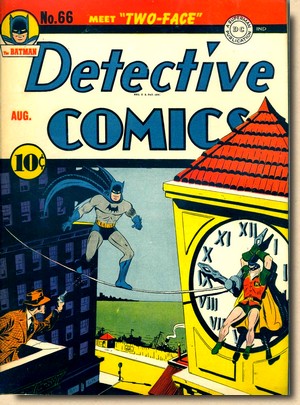 |
|
DETECTIVE
COMICS #66
(AUGUST 1942)
MEET
"TWO-FACE"
"The
Crimes of Two-Face"
(13 pages)
Story - Bill Finger
Art - Bob Kane (signed)
Inks - Jerry Robinson, George
Roussos
Colours - NN
Lettering - Ira Schnapp
Editor - Whitney Ellsworth
Cover - Jerry Robinson (pencils
& inks), George Roussos (backgrounds)
|
|
| |
"HAVE
YOU EVER TOSSED A COIN TO DECIDE SOMETHING...
SETTLE A PROBLEM ABOUT WHICH YOU COULDN'T MAKE UP YOUR
MIND ?
REMEMBER HOW EAGERLY YOU WATCHED TO SEE WHICH SIDE WON...
HEADS OR TAILS ?
OF COURSE YOU WOULDN'T STAKE A LIFE
ON THE FLIP OF A COIN...
BUT HOW ABOUT A MAN WHO STAKED HIS SOUL, HIS VERY ACTIONS
ON THE SPINNING OF A SILVER COIN ?
BECAUSE HE WAS LIKE THAT COIN ITSELF !
HE, TOO, HAD TWO
SIDES;
TWO SIDES AS DISTINCT AS NIGHT AND DAY ... AS GOOD AND
EVIL !
MEET THE MOST BIZZARE CRIMINAL OF ALL TIME ...
A TWENTIETH CENTURY JEKYLL-HYDE ... IN ...
THE CRIMES OF TWO-FACE
!"
|
| |
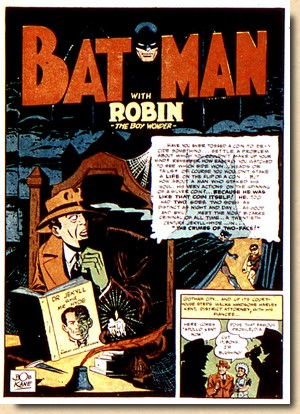 |
|
A classic and
iconic Batman villain who plays an important part
in the popular culture Batman mythology and
universe, former-District-Attorney-turned-bad
Two-Face made his debut early on in the Batman's
publication history, appearing in Detective
Comics #66 (cover dated August 1942) - the
cover of which, as was the case so often in those
days, has absolutely nothing to do with the
actual story (save the caption) ...
PLOT SUMMARY
Gotham
City's handsome District Attorney Harvey Kent -
whose physical appearance has earned him the
nickname "Apollo" - is presenting the
people's case against crime gang leader
"Boss" Moroni in court and produces the
final evidence to squarely convict the mobster:
Moroni's lucky charm, a two-headed silver coin.
Moroni
realizes that his race is run, and in an outburst
of violence - fuelled even more by Moroni's
belief that Kent is responsible for the death of
his father - the gangster jumps forward and
throws acid at the DA. Batman, who is also
present at the court hearing, manages to deflect
most of the acid, but he can't prevent one side
of Kent's face being horribly scared as a result
of the incident.
|
|
| |
| When Kent subsequently
learns that the one plastic surgeon who might be able to
help him has returned to his native Germany and is now
being kept at a concentration camp by the Nazis, his
pitiful situation begins to unbalance him - once admired
for his good looks, he is now seen as a hideous
appearance. |
| |
| Kent
turns completely bitter when his fiancee, a
sculptor, cannot bear the sight of his face, and
as fate has dealt him such a blow, he leaves it
to fate to decide his future path in life.
Scaring one side of Moroni's silver coin, he
flips it - and decides to turn to crime as the
damaged side falls face up into his hand. Public opinion is divided as
Dent, now calling himself Two-Face, commits
crimes or not, depending upon the verdict of the
coin. When Two-Face stages a hold-up in a cinema
(where viewers thrill to the adventures of
Superman) Batman and Robin finally catch up with
him. However, Two-Face makes good use of the
ensuing confusion and manages to escape home -
only to be confronted by Batman, who tries to
convince him to give himself up and promises to
put in a good word for him.
For
Kent, the coin decides, but this time it lands
and stands on its edge. Batman assume sthat
Two-Face will have to toss the coin once more,
but kent tells him that he only takes one chance
ever, and that now only fate can decide what will
happen to his life...
|
|
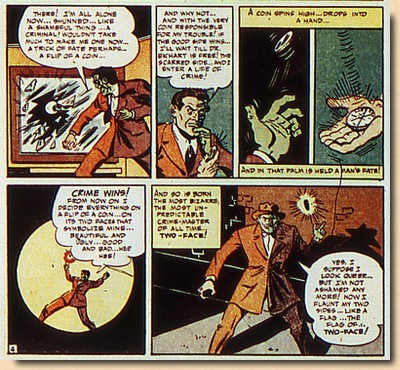
Told
in a mere six panels - the reasoning for a life
of crime and the modus operandi of Two-Face
|
|
| |
REVIEW & ANALYSIS
Being a
story as much as a dedicated origin feature, "The
Crimes of Two-Face" is an example of how a well
conceived and tightly paced Golden Age comic book story
remains readable to this day - and still works. Highly
condensed, for sure, by early 21st century comic book
industry standards, Bill Finger's account of how Two-Face
came to be and why he ticks the way he does, provides
everything which is necessary and leaves out all which is
not.
|
| |
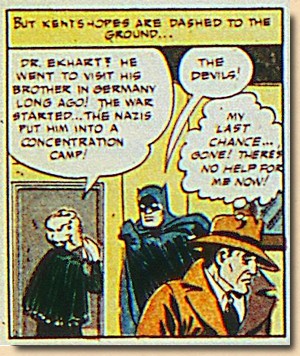
Readers
were reminded that there was a war going on -
although Batman's role in this era was primarily
to appear in ads promoting war bonds
|
|
What would most certainly use
up an entire arc of three or even four entire
issues of comic book space today is made to fit a
mere 13 pages in 1942, and the core elements of
Two-Face's motivation and inner psychology are
crisply told in no more than six panels. Turning
necessity into virtue, Detective Comics
#66 thus provides readers with a new villain and
his origin which is straight to the point and
sticks - you only needed to read this one comic
book to know everything which is essential about
Two-Face. The characters and events are
breathtakingly paced, but Finger managed to avoid
any impression of things being rushed. There are,
naturally, some of the oddities which Golden Age
comic books are so (in)famous for, but they do
not distract from the overall picture and don't
throw post-1960s readers off track, merely
providing some ripples in the otherwise clear
waters as the non-fuss and to-the-point story
moves along.
One
such element is the introduction as plot element
of the war which was raging at the time of
publication, serving as an explanation for Harvey
Kent not being able to contact the one specialist
surgeon who could help him. Not because he has
been killed in an accident, but because he is
held prisoner at a Nazi concentration camp in
Germany. The Darknight Detective's remark to this
is strong on a verbal level, but it reminds
today's readers above all of Batman's generally
passive role in comparison to other superheroes
who fought Nazis all over the place in their
titles.
|
|
| |
| Batman's
Gotham City, however, was devoid of any Nazi or axis
activities, making him a strikingly unpolitical 1940s
comic book superhero in comparison to e.g. Timely's
Captain America. In said Gotham City, Golden Age villains
had a tendency of either disappearing for good after one
stint against the Batman, or they would be back at least
once fairly quickly after their debut. Two-Face fell into
the latter category, making his next appearance in Detective
Comics #68 (October 1942). |
| |
CREATION, EVOLUTION &
APPEARANCES OF THE CHARACTER
"OF ALL THE INMATES IN ARKHAM
ASYLUM HE IS PERHAPS THE STRANGEST...
AND MOST INCORRIGIBLE.
IN THE HALF-LIGHT OF HIS CELL, HE SITS MOODILY FLIPPING A
COIN... OVER AND
OVER...
AS HE HAS FOR MONTHS, AS HE HAS FOR YEARS."
(from the splash page of Batman
#346, April 1982)
Driven mad by the duality of
good and bad luck, right and wrong, good and evil,
Two-Face obsessively makes all important decisions by
flipping a two-headed coin, one side of which is scarred
or scratched over with an X. In earlier appearances, the
crimes of Two-Face followed a pattern based on the number
two; since the 1970s, Two-Face has gone from being a
gimmicked criminal to becoming a murderous psychopath,
bent on destroying and killing Batman whenever the
scarred side of his coin comes up.
|
| |
| According
to Bob Kane's autobiography (Kane, 1989) Two-Face
was inspired by the 1931 movie adaptation of
Robert Louis Stevenson's Strange Case of Dr
Jekyll and Mr Hyde starring Spencer Tracy
(the reference to Robert L. Stevenson's classic
novel is made explicit by showing Two-Face
holding a copy of the book on the splash page).
Additional input was also derived from the pulp
magazine character Black Bat, whose origin story
included having acid splashed in his face. The name Harvey Kent was
dropped (again according to Bob Kane's
autobiography) in favour of Harvey Dent as of Batman
#81 (February 1954) to avoid confusion with
Superman's alter ego Clark Kent.
The Harvey Kent
Two-Face appeared in Detective Comics
#66, #68 (1942) and Detective Comics #80
(1943), when both his face and his mental sanity
were restored. With no retcon set in place, other
characters assumed the role such as Wilkins,
Dent's butler, in 1948/49 by using makeup to
suggest that the reformed Dent has suffered a
relapse and deformed his face to appear as before
(Batman #50, #52). In 1951, actor Paul
Sloane became the second Two-Face when he plays
Harvey Kent in a biography and is disfigured by
an accident on the set (Batman #68).
Sloane's mind snaps and he thinks he is
Kent; this incarnation of Two-Face was used as
Two-Face II of DC's Earth-Two multiverse (Superman
Family #211-212, 1981), and Sloane was
revived as a successor of the original Two-Face
in 2003 (Detective Comics #777). The third
Two-Face of the Golden Age is a small time
criminal named George Blake, who like Wilkins is
wearing make-up (Detective Comics #187,
1952).
Not sitting well
with the more kids-friendly and campy approach
the Batman books were taking in the 1960s,
Two-Face was dropped from the roster of Batman
villains with the exception of a single
appearance in 1968 (World's Finest Comics
#173).
|
|
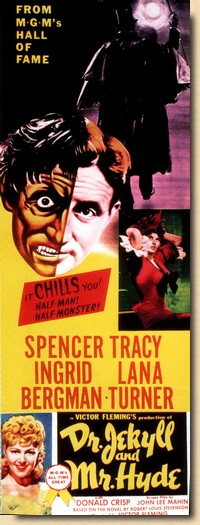
|
|
| |
| Following
his first appearance as Two-Face in Batman #81
(February 1954), Harvey Dent was brought back in August
1971 by writer Dennis O'Neil for "Half an Evil"
in Batman #234, and it was this and subsequent
portrayals which really shaped the character and turned
him into one of Batman's arch-enemies in a series of now
classic 1970s stories appearing in Batman #234
(August 1971), Brave and the Bold #106
(March-April 1973), Batman #258 (September-October
1974), Batman #260 (January-February 1975),
Joker #1 (May 1975), First Issue Special #7
(October 1975), Justice League of America #125
(December 1975), Justice League of America #126
(January 1976), Joker #9 (September-October 1976),
Brave and the Bold #129-130 (September-October
1976), DC Super-Stars #14/2 (May-June 1977),
Teen Titans #47-48 (April-June 1977), Batman #294
(December 1977), Green Lantern Vol. 2 #117 (June
1979), and Batman #312-314 (June-August 1979). |
| |
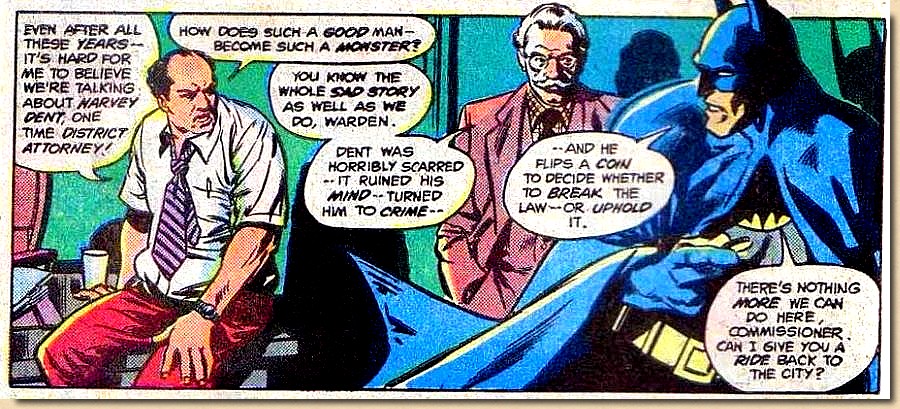
The MO of Two-Face, summed up by
Gerry Conway and Don Newton in one single panel (from Batman
#346, April 1982).
|
| |
| Following
Frank Miller's revision of Batman's origin in Batman:
Year One in 1986, Two-Face's history was also subject
to changes in Batman Annual #14 in order to match
up. Ever since, Two-Face has essentially been portrayed
as having an obsession with duality and fate as the
result of schizophrenia and bipolar/multiple personality
disorders, as opposed to a reaction following a single
traumatising event - also meaning that plastic surgery no
longer presents a "cure" as the mental illness
dominates the outer appearance, and not vice versa. The
modern version is also established as having once been a
personal friend and ally of Commissioner James Gordon and
Batman. |
| |
TWO-FACE
IN OTHER MEDIA
Considered to be too
gruesome and violent for the 1960s Batman
television series, Two-Face eventually appeared
in Batman: The Animated Series
(1992-1995), voiced by Richard Moll. Based on the
post-Year One origin rather than the
classic take from 1942, District Attorney Harvey
Dent is portrayed to suffer from psychological
problems since the time of his youth when he
developed a second split-personality (called
"Big Bad Harv") who shows himself
whenever Dent loses his temper. He finally
becomes completely insane after an explosion in a
factory hideously scars the left half of Dent's
body, and he becomes a gangster known as
Two-Face.
In the 1995 movie Batman
For Ever Two-Face is played by Tommy Lee
Jones, and the character also features very
prominently in The Dark Knight (2008), the
sequel to the 2005 film Batman Begins.
Played by Aaron
Eckhart, Dent is a far darker character in this
movie, portrayed as a tragic hero rather than
suffering from dissociated personalities. At the
end of the movie, Two-Face dies whilst holding
Commissioner Gordon's son as a hostage and
threatening to kill him. In order to cover up
Dent's criminal actions, Batman decides to take
the blame for Two-Face's murders in order for
Dent to be remembered as a hero...
|
|
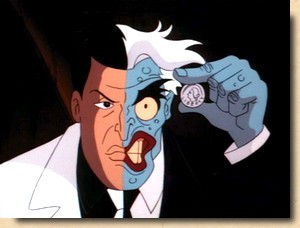 Two-Face
in Batman The Animated Series and Batman The Dark
Knight
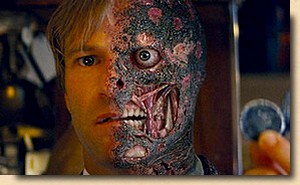
|
|
| |
TRIVIA
Not
surprisingly (given its importance for the Batman
Universe) "The Crimes of Two-Face" has been
reprinted several times and is an easily accessible
Golden Age classic featured in 100-Page Super Spectacular
#DC-20 (September 1973), Batman Archives Vol. 2
(1991), Batman: Featuring Two-Face and the Riddler
(TPB, 1995), Batman Vs. Two-Face (TPB, 2008),
and Batman Chronicles Vol. 7 (2009). The single highest
CGC-graded original copy of Detective Comics #66
clocks in at 9.0 (VF/NM) and was sold at auction in December 2011 for
$10,200.
|
| |
| BIBLIOGRAPHY |
| |
| KANE Bob
(1989) Batman and Me, Eclipse Books |
| |
| |
|










